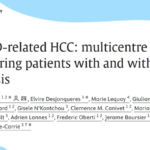
Editorial Note: Fewer than 5% of patients are confirmed to be allergic to penicillin following formal testing. However, even when test results are negative, patients may still retain their penicillin allergy label or incorrectly have it reassigned. Few studies have explored the long-term follow-up data and risk factors associated with self-reported penicillin allergy (SRPA) after successful oral penicillin administration and label removal. Recently, JAMA Network Open published a study addressing these findings.The Penicillin Allergy Clinical Decision Rule (PALACE) study is the first international, multicenter randomized clinical trial to demonstrate that direct oral penicillin (DOC) in adult patients with low-risk penicillin allergy (PEN-FAST score <3) is not inferior to the standard approach of skin testing followed by oral penicillin (control group). A scheduled telephone survey was conducted six months after randomization to assess SRPA, adverse events (AE), and factors related to SRPA.
In the initial study, 377 patients had their penicillin allergy labels removed (247 females, 350 White individuals), and 351 (93.1%) completed the six-month follow-up. The remaining patients could not be contacted by phone. Among those who completed follow-up, 23 (6.6%) reported SRPA, including 13 out of 178 (7.3%) in the intervention group and 10 out of 173 (5.8%) in the control group. Additionally, 34 (9.7%) reported avoiding penicillin use within the six months. Of the 23 SRPA patients, 11 (47.8%) had reported AE during the initial 5-day trial, 7 (30.4%) experienced new AEs, and 5 (21.7%) were determined to have SRPA without any AE reports. Among AEs reported after the 5-day follow-up, 11 out of 13 were immune-mediated (11 out of 351, or 0.3%).
SRPA at the six-month mark was significantly associated with immune-mediated AE reported after the initial 5-day trial (OR 35.44, 95% CI: 9.40–133.60, P<0.001). Baseline characteristics were not associated with SRPA.
Among the SRPA patients, 17 out of 23 (73.9%) used antibiotics within six months after label removal, with 11 out of 17 (64.7%) using penicillin. In contrast, in the non-SRPA group, 123 out of 328 (37.5%) had taken antibiotics, with 66 out of 123 (53.6%) using penicillin.
This secondary analysis concluded that DOC effectively removes the penicillin allergy label, and in most patients, the removal effect persisted for six months. A significant portion of patients successfully used penicillin after label removal, consistent with prior reports.
A few patients reported new AEs, most of which occurred during the initial 5-day trial. Delayed immune responses were not severe, as seen in both 5-day and 6-month follow-ups. Thirteen of 328 (3.9%) patients experienced immune-mediated AE, but none of these patients considered themselves allergic to penicillin at follow-up.
Among AEs related to new penicillin treatments after the initial 5-day follow-up, 11 out of 13 were immune-mediated. In a large retrospective study, 11 of 650 patients (1.7%) who had their allergy labels removed experienced mild delayed reactions. Re-sensitization is suspected with repeated exposure. During the six-month follow-up, 39.8% of the study cohort used antibiotics, with 54.2% using penicillin, emphasizing the importance of label removal in this population.
The study had some limitations. No medical record review was conducted to directly track allergy labels. Furthermore, despite successful label removal and no AE, some patients were still reluctant to take penicillin. Researchers did not investigate the reasons behind this, suggesting a need for qualitative evaluation in patients who test negative but continue to avoid penicillin post-label removal. Nevertheless, the PALACE study demonstrates that for low-risk penicillin-allergic patients, a single dose of DOC is safe and effective in both immediate (5-day) and long-term (6-month) follow-ups.


